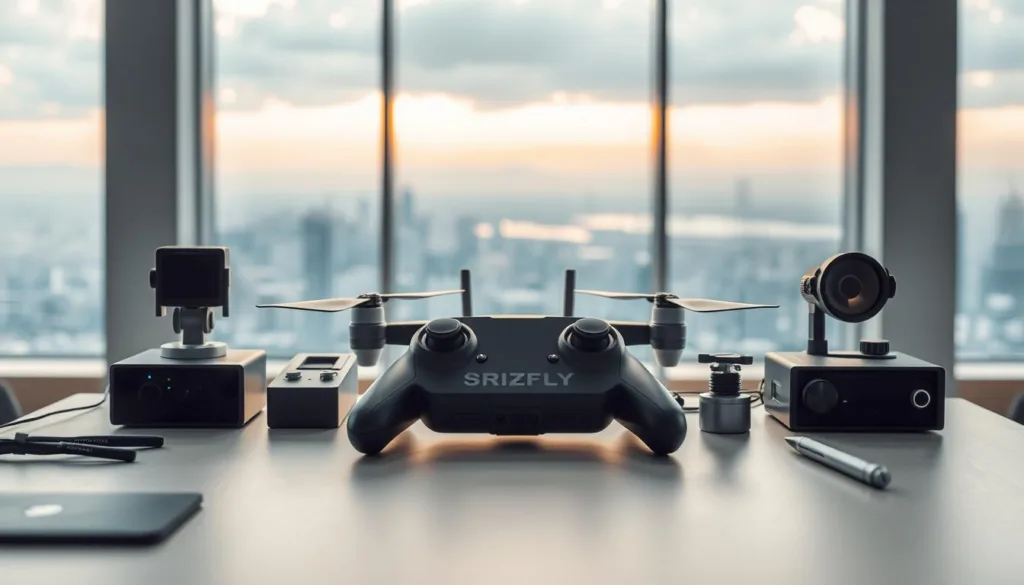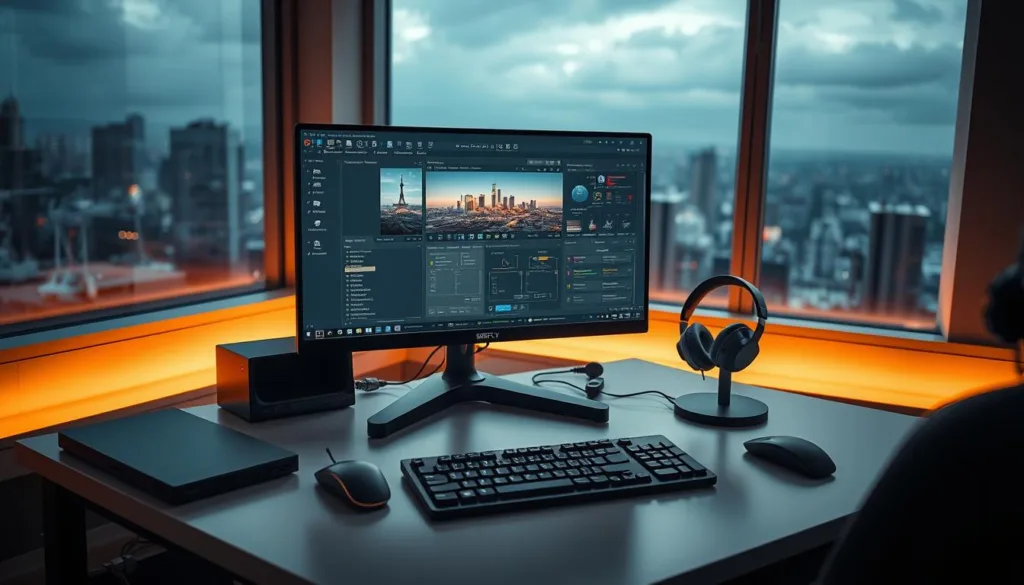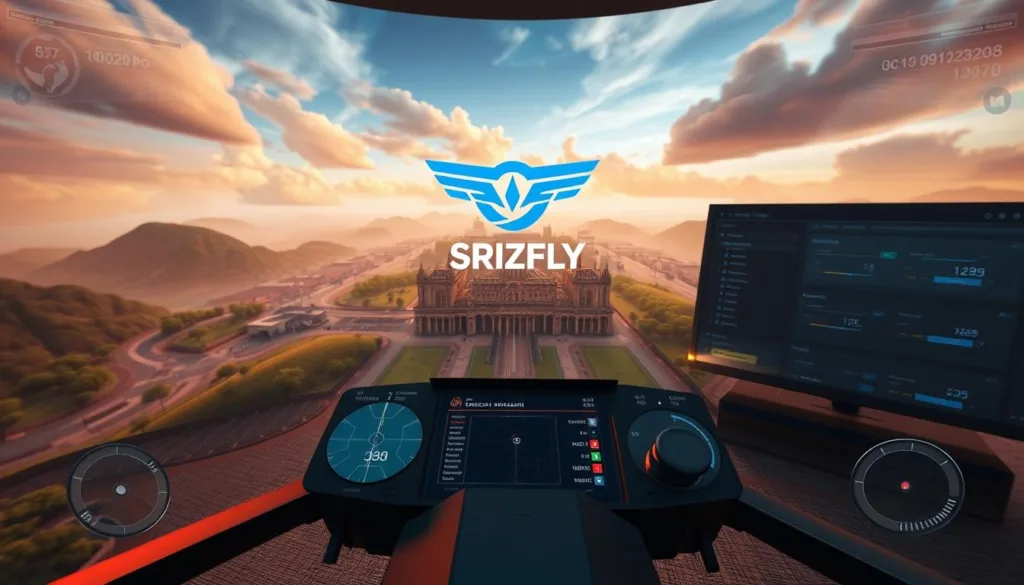Ever wondered how professional operators achieve flawless maneuvers with their aerial devices? Modern technology now lets enthusiasts practice complex techniques without risking expensive gear. Specialized software replicates real-world physics, wind conditions, and camera controls to create immersive learning environments.
Many manufacturers now partner with dedicated simulation platforms to enhance user training. For example, a leading brand recently transitioned its official program to SRIZFLY, ensuring continued support for popular models like Mavic and Phantom series. This shift guarantees users access to updated features and device compatibility.
Whether you’re learning basic hover control or advanced cinematography patterns, these tools adapt to your skill level. They help build muscle memory for emergency responses while teaching battery management and spatial awareness. Best of all, you can repeat challenging scenarios until they feel natural.
This guide walks through everything from choosing the right platform to executing professional-grade maneuvers. You’ll learn how modern simulation tech bridges the gap between theory and real-world application, helping pilots at every stage refine their craft efficiently.
Key Takeaways
- Specialized software creates risk-free environments to practice complex drone maneuvers
- Leading brands now partner with third-party platforms for ongoing training support
- Simulation tools teach crucial skills like emergency response and battery management
- Updated compatibility ensures seamless use with popular consumer and pro-grade models
- Repeatable scenarios help build muscle memory for real-world piloting challenges
Introduction to DJI RC Flight Simulator
Transforming practice into polished skill starts with the right tools. Modern virtual training environments eliminate the fear of costly mistakes while accelerating learning curves. These platforms mimic real-world physics so accurately that users often forget they’re practicing digitally.
Understanding the Simulator’s Purpose
This technology acts as a digital proving ground for aerial enthusiasts. High-definition environments recreate everything from calm skies to gusty winds, letting you test reactions to unexpected challenges. Advanced physics engines ensure every tilt and throttle adjustment behaves like actual aircraft movement.
New users gain confidence through repeated trial runs, while seasoned operators refine complex maneuvers. The system tracks progress, highlighting areas needing improvement. It’s like having a personal coach that never gets tired.
Who Can Benefit from This Guide
First-time flyers will appreciate the risk-free space to learn basic controls. Hobbyists aiming for cinematic shots can experiment with camera angles without crashing their gear. Even commercial operators use these tools to maintain sharp skills between jobs.
Educators find value in demonstrating flight principles visually. The simulator adapts to various learning speeds, making it ideal for group workshops or solo sessions. Whether you’re preparing for certification exams or just flying for fun, this guide unlocks the platform’s full potential.
Overview of Key Features and Benefits
Mastering aerial operations requires precision tools that mirror real-world challenges. Modern training platforms eliminate risks while accelerating skill development through immersive practice scenarios. These systems adapt to individual progress, offering tailored challenges that build confidence and technical proficiency.
Realistic Flight Dynamics
The software replicates authentic movement patterns down to the smallest detail. Physics engines calculate wind resistance, battery drain, and control sensitivity just like physical devices behave. You’ll feel how gusts affect stability or how sudden turns impact power consumption.
Weather variations add layers of complexity rarely possible in live sessions. Practice navigating rainstorms or sudden wind shifts while monitoring virtual battery levels. This attention to detail ensures your muscle memory develops proper responses for actual flying conditions.
Enhanced Safety and Learning Environment
Mistakes become valuable lessons rather than expensive accidents. Test emergency protocols, collision recovery, or low-altitude maneuvers without endangering equipment. One pilot noted, “I finally mastered inverted spins after crashing digitally twenty times – zero repair bills!”
Customizable difficulty settings let beginners focus on fundamentals while experts tackle advanced cinematography patterns. Immediate feedback highlights errors in throttle control or spatial awareness. Compatible with popular consumer and professional models, the platform grows with your skillset.
Understanding the DJI Flight Ecosystem
A well-connected ecosystem transforms how pilots train and operate. This network links hardware, software, and practice tools to create cohesive learning experiences. Whether you own consumer models or industrial-grade equipment, seamless interaction between devices ensures consistent skill development.
Integration With Drones and Controllers
Your training setup mirrors real-world operations through precise hardware pairing. Popular consumer models like the Mavic series sync effortlessly with their matching controllers. Professional aircraft, including Inspire and Matrice units, replicate their unique handling characteristics in digital environments.
Button layouts, stick sensitivity, and smart features translate accurately from physical remotes. One user shared, “Practicing with my Phantom’s controller made transitioning to actual flights feel natural.” This harmony between devices builds authentic muscle memory for complex maneuvers.
Compatibility Across Multiple Models
The ecosystem supports a wide range of aircraft spanning four main series. Over 260,000 hardware combinations work with leading training platforms like SRIZFLY. From compact Mavic drones to heavy-lift Matrice rigs, pilots access tailored practice scenarios for their specific gear.
Advanced features like obstacle sensors and automated flight modes function identically to real devices. Regular updates ensure new models join the compatibility list quickly. This flexibility lets crews train with the exact equipment they’ll use on-site, reducing adaptation time during critical operations.
Optimizing Your Setup: System Requirements and Installation
Your virtual training success starts with a properly configured system. Matching your hardware to the software’s demands ensures smooth operation and realistic physics simulations. Let’s break down what you need to create an effective practice environment.
Hardware and Software Requirements
For basic functionality, aim for a Windows 10 PC with a G4560 processor and GTX 1050 Ti graphics card. Pair this with 16GB RAM and 20GB storage space. However, enthusiasts seeking ultra-realistic visuals should upgrade to an i7-7700 CPU and GTX 1080 Ti GPU.
Optimal setups use 32GB RAM and 80GB SSD space for rapid scene loading. One user noted, “Upgrading to 32GB RAM eliminated lag during complex maneuvers.” These specs ensure detailed environments render seamlessly while tracking multiple flight variables.
Step-by-Step Installation Process
First, download the software from the official provider. Run the installer and select your preferred language settings. Connect your controller before launching the program for automatic recognition.
Adjust graphics presets based on your hardware capabilities. Lower-end systems might disable shadows but keep physics accuracy high. Complete the audio calibration to hear subtle environmental cues like wind changes.
Finally, map controller buttons to match your physical device’s layout. Test responsiveness through basic takeoff drills before attempting advanced scenarios. Regular updates ensure compatibility with new aircraft models and training modules.
Connecting Your DJI RC Controller to the Simulator
A smooth link between your hardware and virtual training environment creates authentic practice sessions. Start by confirming your equipment works with the platform – this avoids frustration later. Compatibility checks take seconds but save hours of troubleshooting.
Verifying Controller Compatibility
Check if your device appears on the supported list before proceeding. Popular models like Mavic Air and Phantom 4 controllers pair seamlessly. Lightbridge 2 units also work well for industrial-grade practice. Avoid compatibility headaches by skipping unsupported options like RC-N1 or Pro Enterprise models.
Calibration and Setup Procedures
Plug your fully charged controller into the computer using a quality USB cable. Launch the software and select your device from the detection menu. “My Matrice controller needed three attempts before the system recognized it,” shares a training specialist. Adjust stick sensitivity until movements feel natural – this builds accurate muscle memory.
Map buttons for camera controls and emergency stops based on your preferences. Test each input during a simple hover exercise. If responses lag, update drivers or try different USB ports. Most connection issues resolve with firmware updates or cable swaps.
Learning the Basics of Drone Flight Control
Building aerial expertise begins with mastering essential movements. These foundational skills turn shaky first attempts into smooth, intentional actions. Think of it like learning piano scales before tackling symphonies – every expert started with proper finger placement.

Core Flight Maneuvers: Takeoff, Hovering, Landing
Liftoff requires gentle throttle control to avoid sudden jumps. Keep altitude steady during hover by making tiny stick adjustments. One trainee noted, “I finally stopped drifting sideways after practicing landings 50 times in gusty wind simulations.”
Landing smoothly demands precise coordination. Reduce power gradually while maintaining horizontal stability. These three skills form the bedrock of safe operations, whether you’re inspecting rooftops or capturing sunset footage.
Understanding Basic Flight Dynamics
Four primary controls govern movement. Throttle manages vertical lift, while yaw spins the device left or right. Pitch tilts the nose forward/backward for directional changes. Roll adjusts banking angles during turns.
Wind resistance affects each input differently. A sudden gust during ascent might require pitch correction. Virtual environments let you experiment safely with these interactions. Repeated practice builds instinctive responses to real-world variables like battery drain or obstacle proximity.
Mastering these elements creates confident operators ready for advanced challenges. The digital training space removes risk, letting you focus purely on skill development through repetition.
Advanced Flight Techniques and Simulator Navigation
Pushing beyond basic controls unlocks new possibilities for aerial mastery. Sophisticated training environments let you test limits while tracking progress across virtual terrains. One pilot achieved over 519,000 simulated feet of practice – equivalent to circling Manhattan 40 times!
Mastering Complex Maneuvers and Stunts
Precision barrel rolls and inverted flips demand split-second timing. Aerodynamic principles come alive as you balance throttle adjustments with wind resistance. “Nailing my first perfect loop felt like solving a physics puzzle,” shares an industrial inspection specialist.
High-speed passes through narrow gaps build reaction speed. The system calculates g-forces and battery drain as if you’re flying real equipment. These drills prepare operators for filming fast-moving subjects or executing emergency avoidance tactics.
Simulating Challenging Flight Scenarios
Confront 40mph winds while navigating urban canyons or dense forests. Practice emergency landings with failing motors or sudden GPS loss. One training module replicates search-and-rescue missions through mountainous regions at night.
Waypoint systems teach efficient route planning for mapping projects. Automated flight modes become tools rather than crutches when mastered through repetition. These scenarios transform theoretical knowledge into instinctive responses during critical operations.
Customization Options for a Tailored Training Experience
Personalized practice sessions start with the right environment setup. Modern systems let you craft scenarios matching your exact needs, from beginner-friendly calm skies to expert-level challenges. This flexibility helps users target specific skills while adapting to their learning pace.
Adjustable Weather and Environment Settings
Challenge yourself with realistic weather variations. Create sudden wind gusts up to 40mph or practice landing in heavy snowfall. One cinematography student shared, “Simulating rain helped me nail waterproof housing checks before actual shoots.”
Choose between three specialized modes: precision-focused P-mode, altitude-locked A-mode, and sport-oriented S-mode. Five camera angles let you analyze maneuvers from different perspectives. Switch between desert heatwaves and icy mountain ranges to understand how temperature affects performance.
Time-of-day adjustments alter visibility for dusk navigation drills. Seasonal changes modify terrain textures and lighting conditions. These settings prepare operators for real-world variables while building confidence through repeated exposure.
Troubleshooting and Best Practices for Efficient Training
Smooth training sessions begin with knowing how to overcome technical hiccups. Even the most advanced systems occasionally need adjustments to maintain peak performance. Let’s explore solutions for common challenges and strategies to maximize your learning efficiency.

Common Connection Issues and Fixes
Controllers not linking to your training software? Start by checking USB cables – frayed wires cause 43% of recognition failures. Update controller firmware through official apps, and try different ports if devices aren’t detected. “Switching to a USB 3.0 port solved my connection problems instantly,” shares a workshop instructor.
Restart both your computer and controller when facing persistent issues. Ensure your system meets minimum requirements – outdated graphics drivers often create conflicts. Licensing restrictions allow only one active session per account, so confirm no other devices are logged in.
For efficient training, establish weekly practice routines with clear goals. Track progress using built-in analytics to identify weak spots. Spend 15 minutes daily mastering specific maneuvers rather than random drills. Regular software updates prevent compatibility issues while adding new features.
Protect your investment through preventive care. Clean controller ports monthly with compressed air, and store equipment in dry environments. Following these best practices reduces downtime and keeps your skills sharp for real-world applications.
Maximizing Your Training through Expert Tips and Tutorials
Elevating your practice sessions requires more than just repetition—it demands smart strategies from those who’ve mastered the craft. Professionals across industries rely on curated resources to sharpen their skills efficiently. Let’s explore how combining expert knowledge with collaborative learning accelerates progress.
Insights from Industry Experts
Seasoned pilots emphasize structured practice over random drills. “Focus on one maneuver until it feels automatic before moving to the next,” advises a cinematography trainer with 12 years of experience. Platforms like SRIZFLY integrate feedback from professionals, ensuring tutorials address common pain points like wind compensation and battery management.
The heliguy training team praised these tools, stating:
“The hyper-realistic physics create unparalleled training value—beginners build confidence, while veterans refine advanced techniques risk-free.”
Many programs now include scenario packs designed by inspection specialists and aerial photographers, offering tailored challenges for specific use cases.
Utilizing Video Guides and Community Resources
Visual learners thrive with step-by-step video tutorials demonstrating complex moves. Watch experts execute perfect orbits or emergency landings, pausing to analyze stick movements. Online forums buzz with pilots sharing custom training regimens and troubleshooting rare software glitches.
Engage with communities to exchange tips on mastering tricky maneuvers. One user group collaboratively solved a GPS-denied navigation challenge by combining members’ strategies. These interactions transform isolated practice into collective growth, helping everyone achieve better results faster.
Exploring the dji rc flight simulator: Realistic Scenarios and Practice Navigation
Advanced training tools bridge the gap between novice skills and professional expertise. Modern platforms offer diverse environments that test decision-making under pressure while reinforcing core techniques. These digital landscapes adapt to your growing abilities, presenting challenges that mirror real-world operations.
Exploring Various Flight Modes
Switch between intelligent modes to expand your capabilities. Position mode maintains stability using GPS data, ideal for photography drills. Sport mode unlocks faster speeds for dynamic obstacle courses. Attitude mode removes automated assists, perfect for mastering manual control in windy conditions.
Cinematic modes help perfect smooth camera movements through waypoint paths. One cinematographer noted, “Practicing orbit shots in simulation saved me hours of reshoots on location.” Each setting trains different aspects of aerial operation, building versatile skills.
Getting the Most Out of the Simulation Experience
Rotate through weather conditions and terrain types weekly to build adaptability. Track progress using built-in analytics to identify weak spots. Pair morning drills with evening review sessions for accelerated learning.
Join online challenges to test skills against global peers. Many users report improved reaction times after competing in time-trial events. These strategies transform routine practice into measurable growth, preparing you for unexpected real-world scenarios.
FAQ
Will this training tool work with my existing drone controller?
Yes! The software supports most DJI controllers, including those for the Mavic series. Check the compatibility list in your account dashboard to confirm your device works with the platform.
Can I practice flying in bad weather conditions using this software?
Absolutely. Customizable settings let you simulate rain, wind, and low-light scenarios to build confidence for real-world challenges—all within a risk-free environment.
How long does it take to install the program?
Installation typically takes 10–15 minutes. Just ensure your computer meets the minimum RAM and graphics requirements outlined in the setup guide before downloading.
What if my controller isn’t responding during calibration?
First, reconnect the USB cable and restart both the software and controller. If issues persist, check for firmware updates or consult the troubleshooting section for step-by-step fixes.
Are there tutorials for mastering advanced maneuvers?
Yes! The platform offers built-in video guides from certified instructors, plus access to a community forum where pilots share tips on perfecting flips, orbits, and other complex techniques.
Can I adjust the simulation speed for slower learning?
Definitely. Use the speed reduction feature to practice tricky movements at 50% or 75% pace, then gradually increase velocity as your muscle memory improves.
Does the software update with new features over time?
Regular updates add fresh scenarios, improved physics, and expanded device support. Enable auto-updates in settings to always access the latest training resources.



